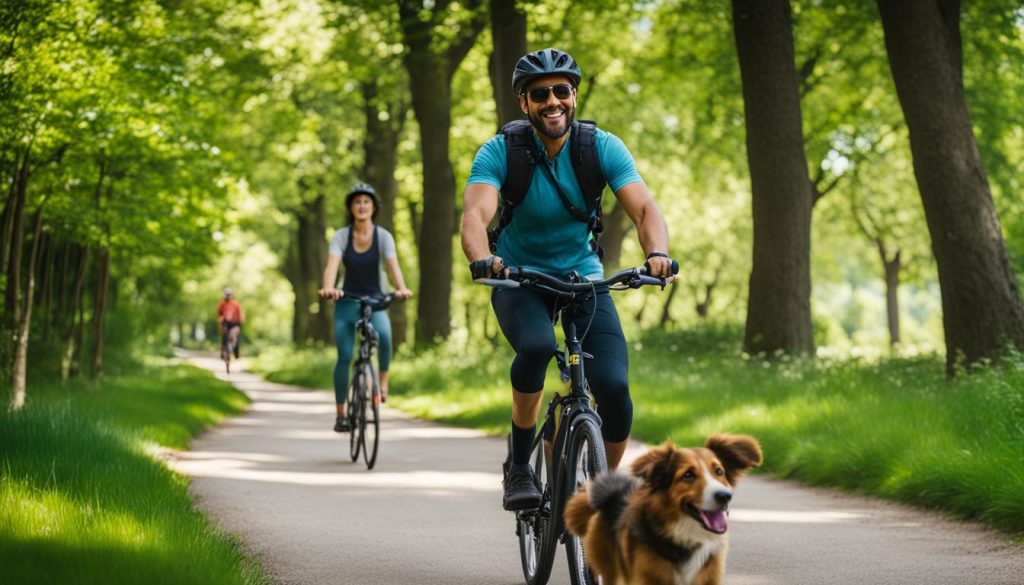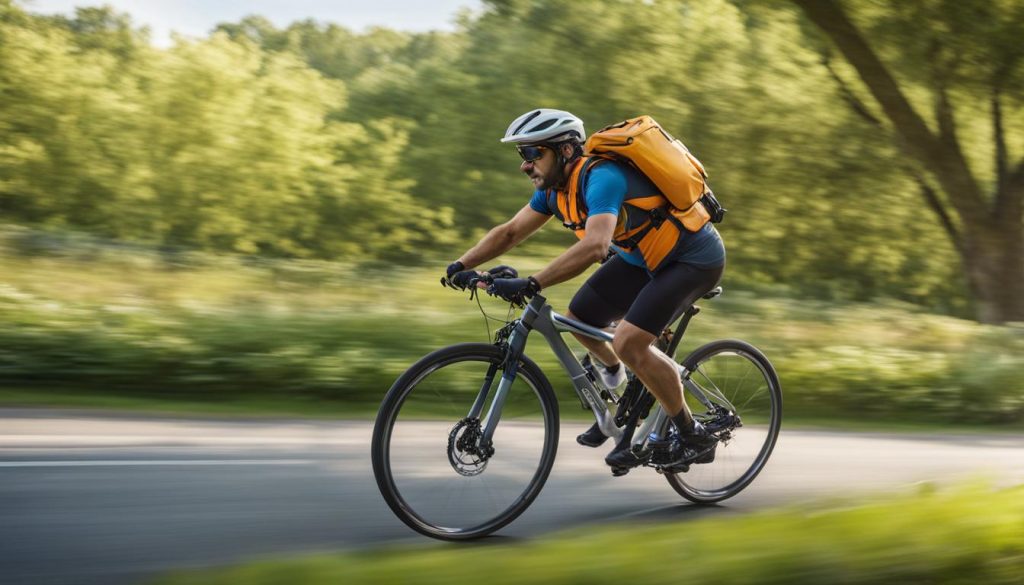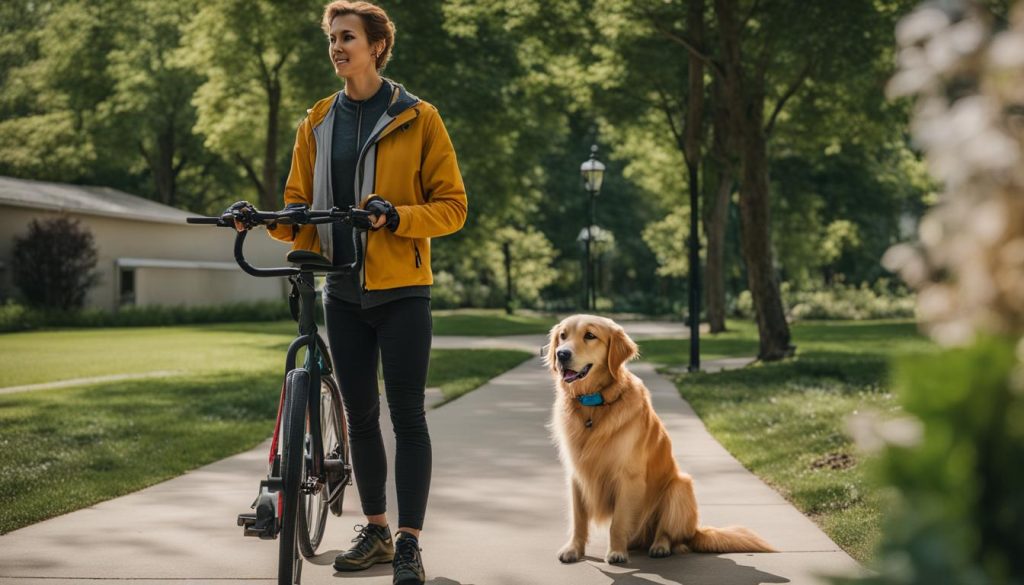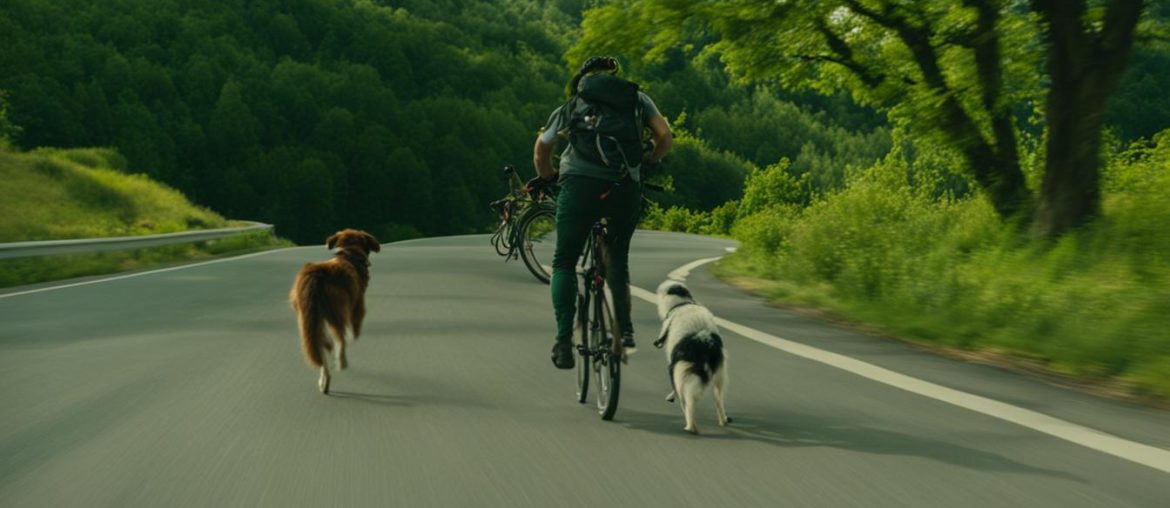Teaching your dog to run alongside your bike can be a great way to provide exercise and mental stimulation. Bikejoring is a popular sport where dogs pull and accompany their owners on bike rides. However, I would advise that you ensure the safety and well-being of your dog throughout the training process. Consult with your veterinarian to determine if your dog is physically fit for this activity.
Key Takeaways:
- Choose the right equipment such as a bike attachment and harness for biking with your dog.
- Ensure your dog is leash trained and has good manners before introducing them to biking.
- Gradually introduce your dog to the bike, starting with calm interactions and walking sessions.
- Start with short and slow rides, closely monitoring your dog’s behavior and comfort level.
- Take safety precautions, avoid hot surfaces, and be mindful of your dog’s limits and physical capabilities.
Choosing the Right Equipment for Biking with Your Dog
When it comes to biking with your dog, having the right equipment is essential for a safe and enjoyable experience. Using a regular leash while biking is not recommended as it can easily become tangled in the bike’s wheels, posing a safety risk for both you and your furry companion. Instead, opt for a bike attachment that keeps the leash secure and prevents any entanglements.
A harness or bungee leash is an excellent choice for biking with your dog. These attachments provide shock absorption, helping to minimize any sudden jerks or pulls from your dog and maintaining better control. Look for a harness that fits your dog comfortably and securely, allowing them to move freely while still ensuring your control over their movements.
When biking with your dog, safety should always be a priority. Just as you would wear a helmet yourself, consider investing in a dog-specific helmet to protect your furry friend’s head in case of any accidents or falls. Additionally, wearing reflective gear for both you and your dog is crucial to ensure visibility, especially during low-light conditions.
To put it simply, choosing the right equipment is key to a successful biking experience with your dog. Prioritize safety, invest in proper gear, and enjoy the adventure of biking with your four-legged companion.
| Equipment | Benefits |
|---|---|
| Bike attachment | Prevents leash entanglement and provides control |
| Harness or bungee leash | Offers shock absorption and comfortable movement |
| Dog-specific helmet | Protects your dog’s head in case of accidents or falls |
| Reflective gear | Enhances visibility during low-light conditions |
Leash Training and Basic Manners for Biking with Your Dog
Before introducing your dog to biking, please ensure they are leash trained and have good manners while walking. Leash training is essential to maintain control and safety during bike rides. If your dog pulls, stops, or runs ahead during regular walks, work on leash training first.
Consider hiring a professional trainer who specializes in dog obedience to help you teach your dog the necessary commands for biking. They can provide guidance on reinforcing good behavior and establishing a strong communication foundation between you and your dog.
Teaching Commands for Biking
When biking with your dog, teach them specific commands that they can easily understand and follow. Some essential commands to teach your dog include:
- Heel: Teach your dog to walk or run alongside you on the same side consistently.
- Slow: Teach your dog to slow down when needed, such as when approaching intersections or other pedestrians.
- Stop: Train your dog to stop and wait for your signal, ensuring they don’t run into potential hazards.
Consistency is key when teaching these commands. Use positive reinforcement techniques, such as treats and praise, to reward your dog for following the commands correctly. Practice these commands in various settings to help your dog generalize the behaviors and improve their overall obedience while biking.
By prioritizing leash training and teaching essential commands, you can ensure a safe and enjoyable experience when biking with your dog. These foundational skills will set the stage for successful bike rides and help you establish a strong bond with your furry companion.

Introducing Your Dog to the Bike
When teaching your dog to run alongside your bike, please take a gradual approach and ensure their comfort and confidence. Start by allowing your dog to be near the bike while it’s at rest, giving them the opportunity to sniff and explore. This will help familiarize them with the bike and create a positive association.
Once your dog is comfortable being near the bike, you can begin walking them on a loose leash while pushing the bike beside them. Start with short walks and gradually increase the duration as your dog becomes more at ease. Be sure to reward calm behavior with praise or treats to reinforce positive associations with the bike.
Consistency is key in this training process. You should also maintain a routine and practice regularly to build your dog’s confidence and trust. With time, patience, and positive reinforcement, your dog will become more comfortable with the bike and ready to progress to the next stage of training.
Building Trust and Confidence
Building trust and confidence is a crucial aspect of introducing your dog to the bike. Aside from the training exercises mentioned above, create a positive environment during the training process. Spend quality time with your dog, engage in playtime, and provide mental stimulation to build a strong bond. This will help your dog feel safe and secure, making them more likely to trust and enjoy the biking experience.
| Training Step | Description |
|---|---|
| Step 1 | Allow your dog to sniff and explore the bike while it’s at rest. |
| Step 2 | Walk your dog on a loose leash while pushing the bike beside them. |
| Step 3 | Gradually increase the duration of walks and reward calm behavior. |
To put it simply, every dog is unique, and the training process may vary. I recommend that you observe your dog’s body language and adjust the training accordingly. If your dog shows signs of fear or discomfort, slow down the process and provide more positive reinforcement. Patience and consistency will play a significant role in successfully introducing your dog to the bike.
Starting with Short and Slow Rides
After successfully introducing your dog to the bike and ensuring their comfort, it’s time to start with short and slow rides. These initial rides will help your dog become more accustomed to running next to the bike and build their endurance. As you begin this phase of training, please pay close attention to your dog’s behavior and comfort level.
Start by planning rides in a safe and controlled environment, such as an empty parking lot or a quiet street with minimal traffic. Begin with short distances, around 5 to 10 minutes, and maintain a slow pace to avoid overwhelming your dog. To put it simply, this is a new experience for them, so be patient and allow them to adjust at their own pace.
During these short rides, observe your dog’s body language for any signs of stress or fatigue. If your dog seems hesitant, tired, or tries to pull away, please stop and regroup. Take breaks as needed and provide plenty of praise and rewards for their effort. Gradually increase the duration and intensity of the rides as your dog becomes more comfortable and confident.
Table: Progression of Short and Slow Rides
| Ride Duration | Pace | Objective |
|---|---|---|
| 5-10 minutes | Slow | Introduce your dog to running next to the bike |
| 10-15 minutes | Slow | Build your dog’s endurance and familiarity |
| 15-20 minutes | Steady | Enhance your dog’s confidence and comfort |
Try to always prioritize your dog’s safety and well-being during these rides. You should also monitor their energy levels, breathing, and overall demeanor. If you notice any signs of overheating, limping, or breathing difficulties, stop the ride immediately and seek veterinary attention if necessary.
By starting with short and slow rides, you will allow your dog to gradually adapt to the new activity, ensuring a positive and enjoyable experience for both of you.

Safety Precautions and Considerations
When biking with your dog, please prioritize their safety. Here are a few important precautions and considerations to keep in mind:
Protecting Your Dog’s Paws
Avoid riding on hot asphalt or other surfaces that can burn your dog’s paws. Opt for shaded paths, dirt trails, or grassy areas whenever possible. If the ground is too hot for you to comfortably place your hand on, it’s too hot for your dog’s paws as well.
Choosing Suitable Pathways
When cycling with your dog, select pathways that are wide enough to accommodate both you and your furry companion. Look for designated bike paths or trails that allow for safe and comfortable riding. This will minimize the risk of collisions with other trail users and provide ample space for your dog to run alongside the bike.
Monitoring for Overheating and Fatigue
Keep a close eye on your dog’s overall well-being during your biking sessions. Watch for signs of overheating, such as excessive panting, drooling, or collapsing. Take frequent breaks to offer water and allow your dog to rest. If you notice any limping, difficulty breathing, or other concerning symptoms, stop the ride and seek veterinary attention.
By following these safety precautions and considering your dog’s well-being, you can ensure a safe and enjoyable biking experience for both you and your canine companion.

Exercising Caution in Different Environments
When biking with your dog, be mindful of the different environments you’ll encounter. The surfaces where you ride can have an impact on your dog’s health and well-being. Hard surfaces like pavement can be tough on your dog’s joints, particularly if they have pre-existing joint problems or arthritis. It’s best to avoid jogging on hard surfaces if your dog’s bones are not fully calcified. Instead, opt for softer surfaces like grass or dirt paths, which are gentler on their paws and joints.
Additionally, please consider your dog’s prey drive and tendencies to chase small animals. Even the most well-trained dogs can get distracted and dart after squirrels, rabbits, or other dogs. This can pose a safety risk for both you and your dog. Ensure that your dog is under control and won’t take off after anything they see during your bike rides. Practice commands like “leave it” or “stay” to reinforce their obedience and help keep them focused on running beside you.
Choosing the Right Pathways
When selecting where to ride with your dog, choose areas with wide pathways that can accommodate both your bike and your dog. Riding on narrow trails can make it difficult to maintain control over your dog, especially if there are other trail users like pedestrians or cyclists. Wide pathways provide enough space for everyone and reduce the risk of accidents or tangles. I recommend that you be considerate of others on the trail and ensure that your dog is well-behaved and doesn’t pose a danger to others.
Always be aware of any local rules or regulations regarding biking with dogs. Some areas may have specific rules or restrictions in place, such as requiring dogs to be on a leash or limiting access to certain trails. Familiarize yourself with these guidelines to ensure that you are in compliance and can enjoy your biking adventures without any issues.
| Surface Type | Pros | Cons |
|---|---|---|
| Grass | Gentle on paws and joints | May be slippery when wet |
| Dirt Paths | Soft and forgiving surface | Can be muddy after rain |
| Pavement | Smooth and predictable surface | Hard on paws and joints |
Biking with your dog can be a fantastic way to bond and provide exercise for both of you. By exercising caution in different environments, choosing the right pathways, and being mindful of your dog’s behavior and limitations, you can ensure a safe and enjoyable biking experience for you and your furry companion.

Knowing Your Dog’s Limits
As responsible dog owners, it is essential to understand and respect our furry friends’ physical capabilities and limits when it comes to biking. Just like humans, dogs have varying fitness levels and health conditions that can affect their ability to run next to a bike safely. Consulting with a veterinarian is crucial to determining the appropriate level of exercise for your dog and identifying any pre-existing conditions that may impact their biking abilities.
Dogs that are overweight, have respiratory issues, or orthopedic injuries may not be suitable for intense bike rides. Excessive exercise can put strain on their joints and exacerbate existing health problems. I would recommend to prioritize your dog’s well-being and choose activities that align with their individual needs. Your veterinarian can provide personalized guidance on the appropriate exercises and intensity for your dog.
Another factor to consider is your dog’s breed and age. Certain breeds, such as brachycephalic breeds (e.g., Bulldogs, Pugs) or dogs with short muzzles, may have difficulty breathing during vigorous exercise. Likewise, puppies and older dogs may have limitations due to their developing or aging bodies. Adjusting the duration and intensity of bike rides to suit your dog’s capabilities is crucial for their safety and well-being.
| Factors to Consider when Assessing Your Dog’s Limits |
|---|
| Weight and body condition |
| Respiratory health |
| Orthopedic issues or injuries |
| Breed characteristics and age |
By understanding your dog’s limits and tailoring their exercise routine accordingly, you can ensure a safe and enjoyable biking experience for both of you. To put it simply, a healthy dog is a happy dog!
Consistency and Positive Reinforcement
Consistency and positive reinforcement are vital when training your dog to run next to a bike. By using consistent commands, rewards, and expectations, you establish clear communication with your dog and reinforce desired behavior. Make sure to choose a specific command for your dog to start running next to the bike, such as “on your bike” or “let’s go.”
During training sessions, use positive reinforcement techniques to motivate and reward your dog. Offer treats, praise, and petting as rewards for successfully following commands and exhibiting appropriate behavior. This positive reinforcement strengthens the bond between you and your dog, making the training process more enjoyable for both of you.
“Consistency is key in dog training. By consistently rewarding your dog for desired behavior, you’re teaching them what you expect and reinforcing their good behavior.”
Avoid punishment or negative reinforcement when training your dog to run next to a bike. Physical or verbal punishment can be detrimental to the training process and may create fear or anxiety in your dog. Instead, focus on positive reinforcement and patience. Don’t forget that each dog learns at their own pace, so be patient and celebrate every small achievement.
Benefits of Consistency and Positive Reinforcement
Consistency and positive reinforcement provide numerous benefits during the training process. Dogs thrive on clear communication and routine, so by consistently using the same commands and rewards, you help them understand what you expect from them. This clarity leads to faster learning and improved obedience.
Positive reinforcement also creates a positive association with running next to the bike, making the activity more enjoyable for your dog. When your dog receives treats, praise, and affection for their efforts, they will start to associate biking as a rewarding and fun experience. This positive association strengthens the bond between you and your dog, fostering a deeper sense of trust and cooperation.
Summary
Consistency and positive reinforcement are crucial elements of training your dog to run next to a bike. By using consistent commands, rewards, and expectations, you establish clear communication and reinforce desired behavior. Positive reinforcement, such as treats, praise, and petting, motivates and rewards your dog, making the training process enjoyable. Avoid punishment or negative reinforcement, as it can hinder progress and damage the bond between you and your dog. Embrace consistency and positive reinforcement, and watch as your dog becomes a confident and reliable companion on your biking adventures.
Gradual Progression and Building Trust
When teaching your dog to run next to a bike, taking a gradual approach is key to building trust and confidence. Start with short, slow rides to allow your dog to become familiar with the bike and the experience of running alongside it. This initial phase is crucial for your dog to feel comfortable and safe in this new activity. Reward their calm behavior with praise or treats to reinforce positive associations with the bike.
As your dog becomes more accustomed to running next to the bike, gradually increase the duration and intensity of your rides. Monitor their behavior closely, looking for signs of fatigue or hesitation. I recommend that you be patient and adjust your training according to your dog’s progress. Every dog is unique, so the timeline for each individual may vary.
During the training process, focus on strengthening the bond between you and your dog. Use positive reinforcement techniques such as treats, praise, and petting to motivate and reward your dog for desired behavior. This will create a positive and enjoyable experience for both of you, reinforcing the trust and connection you share.
| Bike Training Tips: | Key Takeaways: |
|---|---|
| Start with short, slow rides | Gradually increase duration and intensity |
| Reward calm behavior with praise or treats | Foster trust and confidence |
| Monitor your dog’s behavior closely | Adjust training according to progress |
| Use positive reinforcement techniques | Strengthen the bond between you and your dog |

To put it simply, building trust takes time, so be patient with your furry friend. Gradually progressing in your training and allowing your dog to become comfortable with running next to a bike will ultimately lead to a successful biking experience. Enjoy the process, and cherish the bond that forms between you and your dog as you embark on this exciting adventure together.
Final Thoughts
To sum it up, teaching your dog to run next to your bike can be a fantastic way to provide them with exercise and mental stimulation. Bikejoring, a popular sport, allows dogs to pull and accompany their owners on bike rides. However, it is good practice to prioritize your dog’s safety and well-being throughout the training process. Consulting with your veterinarian to ensure your dog is physically fit for this activity is essential.
Choosing the right equipment is crucial when biking with your dog. You should avoid using a regular leash and instead opt for a bike attachment that keeps the leash clear of the bike’s wheels. Look for a harness or bungee leash that provides shock absorption and helps maintain control. Always prioritize your dog’s safety by wearing a helmet and other safety gear while biking.
Before introducing your dog to biking, ensure they are leash trained and exhibit good manners while walking. If your dog pulls, stops, or runs ahead during regular walks, you should work on leash training first. Consider hiring a professional trainer to help teach your dog the necessary commands and reinforce good behavior. Building a strong communication foundation is crucial for a successful biking experience.
In the beginning, you should take a gradual approach when introducing your dog to the bike. Start by allowing them to be near the bike while it is at rest, letting them sniff and smell it. Then, progress to walking your dog on a loose leash while pushing the bike beside them. Reward calm behavior with praise or treats. Be patient and consistent as your dog becomes comfortable with the bike.
By starting with short and slow rides, you can gauge your dog’s behavior and comfort level. If your dog seems hesitant, tired, or tries to pull away, stop and regroup. Gradually increase the duration and intensity of the rides as your dog becomes more accustomed to running next to the bike. Always prioritize safety, carry water, take breaks, and monitor your dog closely for any signs of overheating or discomfort.
You should be cautious in different environments when biking with your dog. Hard surfaces like pavement can cause joint issues, so avoid jogging on them if your dog has pre-existing joint problems or arthritis. Additionally, be mindful of your dog’s prey drive and tendencies to chase small animals. Ensure your dog is under control and won’t dart after squirrels, rabbits, or other dogs during your bike rides.
Knowing your dog’s limits is essential when it comes to biking. Consider your dog’s physical capabilities, any health issues, breathing difficulties, or orthopedic injuries they may have. Consult with your veterinarian to determine the appropriate level of exercise for your dog and any pre-existing conditions that may affect their ability to run next to a bike safely.
Consistency and positive reinforcement are key to successful training. Use positive reinforcement such as treats, praise, and petting to motivate and reward your dog for desired behavior. Avoid punishment or negative reinforcement, as these can hinder the training process and strain the bond between you and your dog.
Lastly, take a gradual approach to training and allow your dog to build trust and confidence in running next to the bike. Progress from short, slow rides to longer and faster ones as your dog becomes more comfortable and proficient. Continuously monitor their behavior and adjust your training accordingly. Try to focus on strengthening the bond between you and your dog through positive reinforcement and enjoyable biking experiences.
To sum it up, biking with your dog can be a rewarding experience that provides exercise and mental stimulation. By following proper training techniques, prioritizing safety, and understanding your dog’s capabilities, you can effectively teach your dog to run next to your bike. Always consult with your veterinarian for personalized guidance and enjoy the fun and adventure of biking with your canine companion.
FAQ
Is biking with my dog safe?
Biking with your dog can be safe if proper precautions are taken. Ensure you have the right equipment, prioritize your dog’s safety, and monitor their behavior closely during rides.
What equipment do I need for biking with my dog?
Avoid using a regular leash and opt for a bike attachment that keeps the leash away from the bike’s wheels. Look for a harness or bungee leash that provides shock absorption and helps maintain control over your dog.
How do I introduce my dog to the bike?
Start by allowing your dog to be near the bike while it’s at rest. Then, progress to walking your dog on a loose leash while pushing the bike beside them. Reward calm behavior with praise or treats to build comfort and confidence.
What should I do if my dog pulls or stops during regular walks?
If your dog pulls, stops, or runs ahead during walks, work on leash training first before introducing them to biking. Consider hiring a professional trainer to help teach necessary commands and reinforce good behavior.
How can I ensure my dog’s safety while biking?
Always prioritize your dog’s safety by wearing a helmet and other safety gear while riding. Avoid riding on hot asphalt, carry water for your dog, and monitor them closely for signs of overheating, limping, or breathing difficulties.
Can any dog run next to a bike?
Not all dogs are physically fit for intense bike rides. Consult with your veterinarian to determine if your dog is suitable for this activity, especially if they are overweight, have health issues, breathing difficulties, or orthopedic injuries.
How should I train my dog to run next to the bike?
Consistency and positive reinforcement are key. Start with short and slow rides, gradually increasing duration and intensity. Focus on building trust and reinforcing good behavior through rewards and enjoyable biking experiences.
Can I bike with my dog in any environment?
Be mindful of the surfaces where you ride, as hard surfaces like pavement can cause joint issues, especially for dogs with pre-existing joint problems or arthritis. Also, consider your dog’s prey drive and ensure they won’t chase small animals during your rides.
How do I ensure a successful biking experience with my dog?
Prioritize safety, understand your dog’s capabilities, and build a strong communication foundation through training. Be consistent in your commands and rewards, avoid punishment, and enjoy the adventure of biking with your canine companion.






